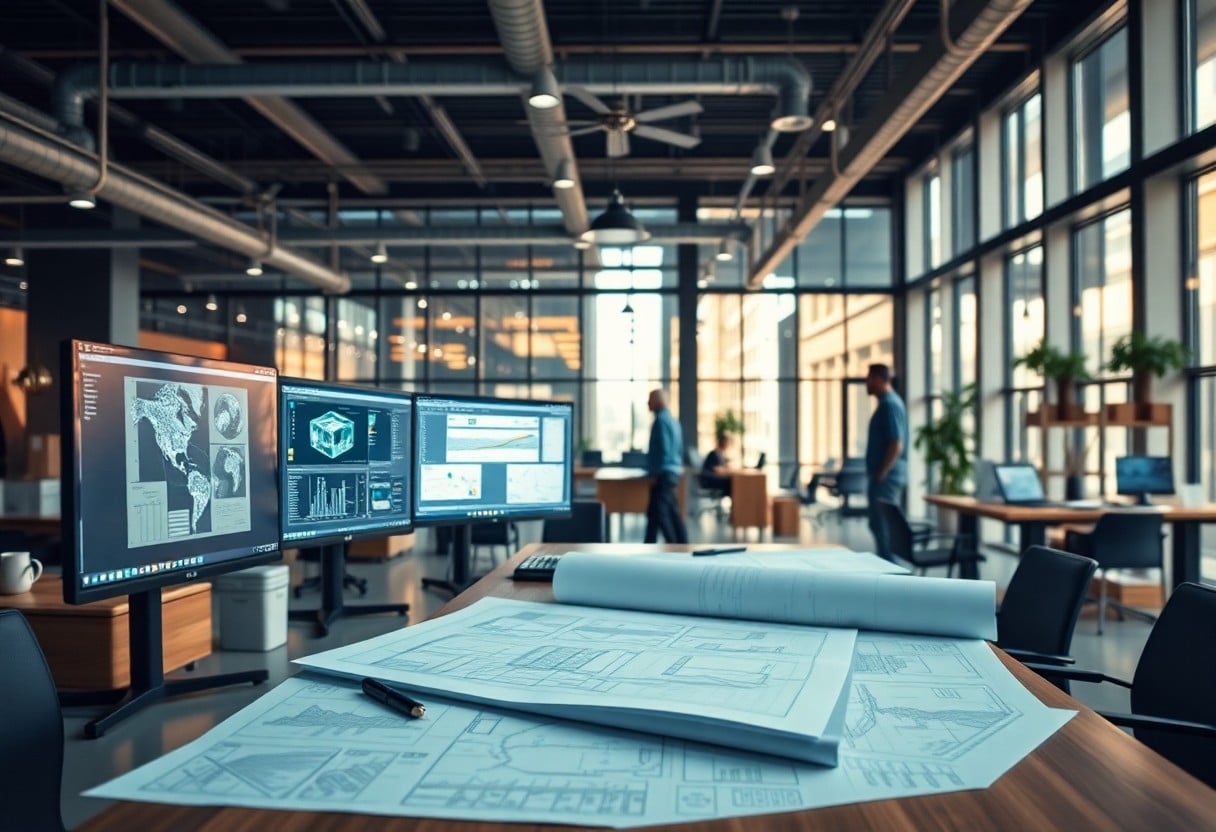How CAD tools are revolutionizing architectural design?
In today's world of architectural designComputer Aided Design (CAD) ToolsThe use of these tools has revolutionized the way you design. These tools not only enable you to create accurate drawings and 3D models, but also dramatically increase the efficiency and creativity of the design process. Whether you are performing complex structural analyses or simulating a building's real-world environment, CAD tools enable you to achieve more detailed designs in less time, with significantly reduced cost and risk. By mastering these technologies, you will be able to differentiate yourself in a highly competitive market.
Key Points:
- improve efficiency: CAD tools can significantly reduce design time and increase the productivity of architects.
- Accuracy: The use of CAD tools improves design accuracy and reduces errors and rework.
- visualization: CAD tools provide 3D modeling capabilities to make designs easier to understand and facilitate communication with clients.
- Data Management: CAD systems enable better management of design data and facilitate file sharing and collaboration.
- simulation analysis: Structural and environmental simulations can be performed to help designers predict the performance of buildings.
- Innovative Design: CAD tools make complex shapes and innovative designs feasible and inspire design.
- cost control: CAD tools can help control construction costs through accurate budgeting and material estimation.
The Evolution of Architectural Design
Over time, architectural design has undergone many significant changes, progressing from the earliest hand-drawn drawings to modern computer-aided design (CAD) tools. These changes have not only affected the workflow of architects, but have also altered design thinking and practice across the industry, promoting innovation and efficiency in design.
Traditional Methods
Prior to the advent of digital tools, architects often relied onHand drawing and modelingThese traditional methods can spark creativity, but they are slow and error-prone. While these traditional methods can inspire creativity, they are slow and error-prone, and can be challenging to modify, putting a strain on time and budgets.
The emergence of digital tools
With the advancement of technology, digital tools began to enter the field of architectural design, revolutionizing the way design is done.The popularity of CAD software allows you to design inComplex design changes in minutesThis makes it easy to create more accurate models. This not only dramatically improves design accuracy, but also significantly reduces the risk of human error.
The advent of digital tools has brought about aDesign RevolutionThe Virtualization Toolkit enables you to take full advantage of the benefits of simulation and visualization. You can effectively test design ideas in a virtual environment, accelerate the iterative process, and identify potential problems early in the project. In addition, these tools often include resource management features that help you control your budget and time effectively, thus improving your overall project success.
CAD Tools Overview
In today's world of architectural designCAD tools(computer-aided design tools) have become indispensable. These tools not only improve design efficiency, but also promote innovative thinking. With accurate digital modeling and a wide range of features, CAD tools help you better meet customer needs and design challenges.
Definitions and Functions
CAD toolsIt is software for creating, modifying, analyzing and optimizing designs. Its main features include 3D modeling, drawing automation, and visualization, which make the design process more efficient. You can use these tools to quickly generate technical drawings and simulate design effects.
CAD Software Type
There are many different types ofCAD SoftwareThey are suitable for different design requirements. They can be categorized as follows according to their functions and uses:2D Drawing Software,3D Modeling Software,Building Information Modeling (BIM)Software and more. Each offers unique advantages to help you realize efficiency in your designs.
| Type | Explanation |
| 2D Drawing Software | Used to create floor plans and technical drawings. |
| 3D Modeling Software | Used to generate 3D views to help visualize designs. |
| BIM Software | Integrate design and construction to support project management and collaboration. |
| Professional Design Software | Customized for specific industries, such as mechanical or electrical design. |
- You need to knowDifferent types of CAD softwareto select the tool that best suits your needs.
- Each type of software has its ownspecific functionrespond in singingStrengthsThe
- Choosing the right tools can enhance yourDesign Efficiencyrespond in singingQualityThe
- Automation of the design process helps to reduceerror rateThe
- CAD tools with different functions can significantly improve the efficiency of the design process.
In the selection ofCAD Software TypeWhen considering your needs and workflow, you need to take into account your own needs. For beginners, 2D drafting software may be easier to use, while professionals who need to work on more complex designs may choose 3D modeling or BIM software. These tools areutilizationNot only does it improve the design of theFlexibilityI'm not sure it's a good idea.Collaborative EfficiencyThe
| Software Type | use |
| 2D Drawing Software | Prepare floor plans and construction drawings. |
| 3D Modeling Software | Create 3D models to visualize the design. |
| BIM Software | Uniformly manage design project information and support teamwork. |
| Professional Design Software | Specialized functions for specific industries to meet professional needs. |
- insightCAD SoftwareThe variety and functionality of our products can help you make smarter choices.
- Enhanced automation of the design process helps to improveefficacyThe
- The right tools can enhance the design ofQuality and AccuracyThe
- Different types of software for differentApplication RequirementsThe
- With the choice of CAD tools, you will be able to do your design work more efficiently.

Improvement in design accuracy
With CAD tools, you'll experience a dramatic increase in design accuracy, which not only meets your customers' needs, but also significantly reduces rework rates. With precise data and specifications, CAD technology allows you to visualize every detail of the design process. To find out more, see our guide to10 Steps to Mastering the Rules for Commercial Use of DronesThe in-depth exploration of the
Precision and Detail
With CAD tools, you can achieve an unprecedented level of precision in your designs that cannot be matched by traditional hand-drawn designs. The system can provide specific dimensions for each element, making your work even more perfect.
Reducing Human Error
With CAD technology, you can significantly reduce common human errors, which helps to ensure the overall quality and reliability of the design. In the traditional way, manual calculations and tracings are prone to errors, and with the help of CAD tools, the system reduces these risks.
In building design, human error can cause major problems and even jeopardize safety. With CAD tools, the system automatically checks and alerts you to potential errors, which not only increases efficiency, but also ensures the accuracy of each design. Your designs are no longer dependent on your personal computing power, making the process more efficient and safer.

Streamline the design process
In architectural design, the use of CAD tools makes the design process more efficient. You can use these tools to create and modify designs quickly, significantly reducing the time and effort required for hand-drawn or traditional methods. By automating some of these processes, you'll be able to focus on creativity and practice, improving the overall quality of your designs. To learn more about the impact of this, please seeWhat aerial composition tips make your drone photography stand out?The
Efficiency of workflow
With CAD tools, you will experience an unprecedented level ofWorkflow efficiencyThese tools help you take full control of your design process. These tools help you take full control of your design process, reducing the possibility of rework and errors and enabling the rapid generation of accurate architectural sketches. In this way, you can achieve greater design accuracy in less time.
Collaboration among stakeholders
CAD tools not only enhance the creativity of designers, but also facilitate the development of diverseCollaboration among stakeholders. Architects, engineers and owners alike can seamlessly share designs and provide instant feedback. This collaboration enhances the overall coordination of the project and ensures that everyone is working towards a common goal, ultimately resulting in the best possible design outcome.
Further, effective collaboration between stakeholders is more than just sharing information; it often means that different professional perspectives come together. In a CAD-enabled environment, you can easily incorporate the views of all parties, applying real-time modeling and modifications to reflect requirements in real time, which not only enhances the success of a project, but also strengthens the design's rationality and constructability. In this way, you'll have true collaboration, with each stakeholder feeling more involved and accountable in the design process.

Visualization and Presentation
Using CAD tools, you can create stunning visualizations that help clients better understand design concepts. The high-quality images and animations provided by these tools allow you to present your architectural designs in a comprehensive manner, thereby communicating ideas and concepts more clearly. With this visualization, clients can make decisions faster, making the design process more efficient. For more information, please refer toStep by Step - The 6 Best Techniques for Drone 3D ModelingThe
3D modeling capabilities
Your architectural design can be visualized through3D modelingThe tool translates directly into three-dimensional entities, enabling you to view your design from different perspectives. This ability not only improves the intuitiveness of your design, but also saves time and resources by allowing you to identify potential problems at an earlier stage.
Improve customer communication
With CAD tools, you can effectivelyImprove communication with customersThe project is a great opportunity for the client to understand the progress of the project and its details. Through clear visualization and timely updates of design versions, clients can more easily understand the progress of the project and its details. This transparency helps inspire trust in the client and facilitates cooperation.
In modern architectural design, theImprove customer communicationIt's critical. Using CAD tools allows you to quickly share the progress of your design with your client and receive instant feedback. This not only fosters a closer working relationship, but also identifies potential misunderstandings or problems in advance, ultimately increasing the chances of a successful project. At the same time, an enhanced sense of client engagement leads to greater confidence in the design process, which is important for building long-term partnerships.
Sustainable Design and Analysis
Sustainability has become a critical consideration in today's building design, and CAD tools can help you conduct in-depth sustainable design and analysis to minimize environmental impact. These tools provide accurate data and simulations to evaluate a building's energy consumption, water usage and material selection, allowing you to make better decisions during the design process.
Energy efficiency modeling
With the help of CAD tools, you can carry outEnergy efficiency modelingThis will help you predict the performance of your building under different conditions. By modeling AV natural light, climate conditions, and energy demand, you can identifyEnergy Saving MeasuresThis will enhance the energy efficiency of the buildings and ultimately reduce the operating costs and environmental impacts.
Life cycle assessment tools
Life Cycle Assessment tools enable you to assess the environmental impact of building materials and construction processes as a whole. These tools can analyzeEnergy consumption, carbon emissionsThe design of the building, the use of materials and the management of waste help you to make smarter choices and make the overall design more sustainable.
The Life Cycle Assessment tool not only analyzes the environmental impact of building materials, but also gives you an idea of the impact of your products on the environment.Manufacture, Use and Final DisposalOverall performance of the stages. By evaluating the data from each stage, you can easily identify the most environmentally friendly materials and technologies to incorporate into your design.Principles of SustainabilityIn addition, it will enhance the social responsibility and environmental image of the whole building.
How can CAD tools revolutionize architectural design?
You can redefine the possibilities of architectural design with CAD tools that not only improve design accuracy, but also shorten workflow time. With 3D modeling and automation capabilities, you can easily visualize and modify your designs to increase creativity and efficiency. What's more, CAD makes teamwork smoother, so you can share updated information with other designers and stakeholders, which is key to improving project success. When you have these tools at your fingertips, you'll be able to embrace a new era in architectural design.
Frequently Asked Questions
Q: How can CAD tools revolutionize architectural design?
A: CAD (Computer Aided Design) tools enable architects to create and modify designs more efficiently by providing precise drawing and design capabilities. These tools allow users to create detailed 3D models for easy visualization and adjustment of design solutions.
Q: What are the main advantages of using CAD tools?
A: The key benefits of using CAD tools include improved design accuracy, time savings, teamwork, and increased design innovation.CAD automates many complex tasks, allowing designers to focus on creative work.
Q: What is the impact of CAD tools on the design process?
A: CAD tools have a profound impact on the design process, as they enable architects to create and modify designs faster, perform real-time simulations and analyses, and better evaluate the feasibility and functionality of designs.
Q: How can CAD tools facilitate collaboration between teams?
A: CAD tools can be shared and collaborated among different members, supporting multiple users to work on the same file at the same time, which improves the transparency of information and speeds up the whole design process.
Q: Do I need specialized training to use CAD tools?
A: Yes, while some CAD software is easy to get started with, in most cases specialized training is required to familiarize yourself with its features and best practices in order to realize its full potential.
Q: How can CAD tools improve the sustainability of architectural design?
A: CAD tools help architects perform energy simulations and environmental impact analyses to optimize the use of materials and building layouts to enhance overall sustainability and environmental friendliness.
Q: What is the future trend of CAD tools?
A: In the future, CAD tools will increasingly incorporate artificial intelligence and virtual reality technologies to improve design intelligence and interactivity, and to make the design process more intuitive and efficient.




